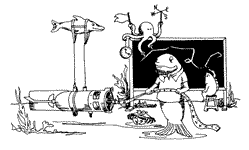|
|
|
| |
Home
Abstracts
Technical Program
Schedule of presenters and events.
Accomodations
Reserving your room at the Bahia Hotel
Order the Proceedings
Information and order form.
Committee and Contact Info
Who and how to contact the presenters and organizers.
|
|
| |
|
|
On the Accuracy of Acoustic Doppler Current Profilers for In-situ
Measurements. A Proposed Approach and Estimations for Measurements in
Tidal Channels
S. Jiménez-González1, R. Mayerle1 and J. J. Egozcue2
1Coastal Research Laboratory and Research and
Technology Centre
Westcoast, University of Kiel.
Otto–Hahn–Platz 3, 24118 Kiel, Germany.
Tel. 49–431–8803641,
Fax. 49–431–8807303,
E-mail: rmayerle@corelab.uni-kiel.de
2Departament de Matemàtica Aplicada III,
Universitat Politècnica de Catalunya. Mod. C2,
Campus Nord. Jordi Girona Salgado 1-3,
08034 Barcelona, Spain.
E-mail: juan.jose.egozcue@upc.es
Although information on the accuracy of Acoustic Doppler Current Profilers
(ADCPs) is available for laboratory conditions, very little is known
about their performance in the field. This paper presents an approach
for estimating the accuracy of these devices for field conditions. Measurements
carried out in a tidal channel (mean tidal range of 3.5m) on the German
North Sea coast were used. The measurements were gathered simultaneously
from two vessels equipped with similar devices travelling side-by-side.
21 transects giving a total of 686 simultaneous profiles were considered.
Only velocity profiles with the maximum point velocity magnitude values
over 0.3 m/s covering ranges of depth-integrated velocities from 0.28m/s
to 1.06m/s were considered in the analysis.
The estimation of the variability of point measurements, required in
the computation of the probability intervals, was obtained on the basis
of the simultaneous measurements. Logarithmic velocity distributions
were fitted through the measured data by using weighted least squares
regression techniques allowing the formulation of a point estimator.
The accuracy in the resulting depth-integrated velocity values was estimated
by computing several probability intervals on the basis of re-sampling
techniques. The reduction in accuracy of the devices closer to the sea
bottom was also accounted for.
The standard deviation for ADCP point measurements resulted about 0.06m/s
and 0.14m/s for distances above and below 1m from the sea bottom respectively.
The accuracy of the devices for the depth-integrated velocity values
resulted approximately constant and equal to ±0.015m/s. No dependency
between the length of the confidence intervals and the water depths
or the depth-integrated velocities was identified
Submitted on January 22, 2003
|
